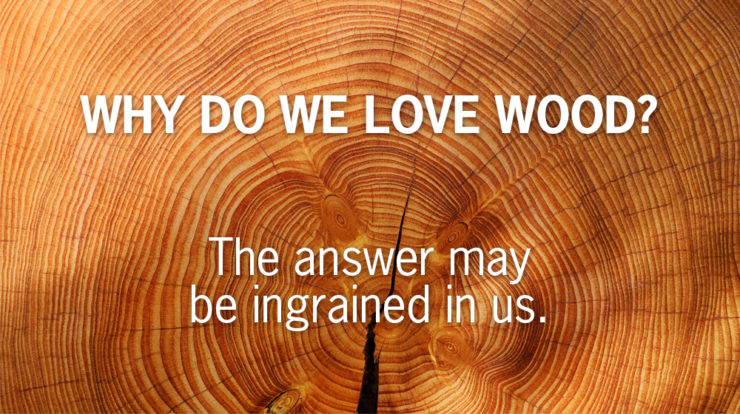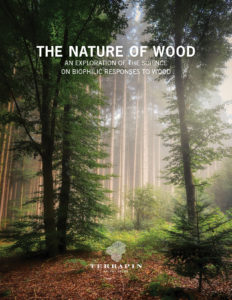

News
The Nature of Wood – a new white paper by Terrapin
Catie Ryan
Share
Why we love wood may be ingrained in us. Terrapin’s new report is a deep dive into what this biophilic connection is all about.
Wood is making a comeback in the built environment and, though most often covered by media for presenting an opportunity to reduce carbon footprints in building construction, awareness of the physiological and psychological impacts of wood products and structures is beginning to take hold. We anticipate the pool of research to steadily grow, explaining why people respond positively to the touch and smell of wood, and to the sight of wood grain and color.
Indirect references to existing research already abound and industry will naturally use this information to their benefit. A recent marketing effort by Restoration Hardware, “True Grain”, explicitly focused on the “rustic grain of the solid oak” of their Cayden Campaign Collection of wood furniture (view online).
Anecdotally, we know when the multi-sensory experience of a space is contributing positively to the ambiance of a space. But what is really happening to us when we have those experiences? Terrapin pursued available research on haptic, olfactory and visual experiences of wood. The deep dive was framed by asking one question: Why do we inherently prefer wood? The effort culminated in “The Nature of Wood”—an exploration of the science that begins to explain why people have ‘biophilic’ responses to wood.
To see the forest for the trees, we must also see the built environment for the materials, products and experiences embodied within it. Let’s start with wood. Download and share Terrapin’s newest whitepaper The Nature of Wood: An Exploration of the Science on Biophilic Responses to Wood.
Filed under:
Catie Ryan
Catie is the Director of Projects at Terrapin and a leader in biophilic design movement. With a background in urban green infrastructure, Catie's interest lies in systems thinking to address human health and sustainability challenges at each scale of the built environment.
Topics
- Environmental Values
- Speaking
- LEED
- Terrapin Team
- Phoebe
- Community Development
- Greenbuild
- Technology
- Biophilic Design Interactive
- Catie Ryan
- Spanish
- Hebrew
- French
- Portuguese
- Publications
- Occupant Comfort
- Materials Science
- Conference
- Psychoacoustics
- Education
- Workshop
- Mass Timber
- Transit
- Carbon Strategy
- connection with natural materials
- interior design
- inspirational hero
- biophilia
- economics of biophilia
- Sustainability
- wood
- case studies
- Systems Integration
- Biophilic Design
- Commercial
- Net Zero
- Resorts & Hospitality
- Energy Utilization
- Water Management
- Corporations and Institutions
- Institutional
- Ecosystem Science
- Green Guidelines
- Profitability
- Climate Resiliency
- Health & Wellbeing
- Indoor Environmental Quality
- Building Performance
- Bioinspired Innovation
- Biodiversity
- Residential
- Master Planning
- Architects and Designers
- Developers and Building Owners
- Governments and NGOs
- Urban Design
- Product Development
- Original Research
- Manufacturing
- Industrial Ecology
- Resource Management
- Sustainability Plans
- Health Care
- Carbon Neutrality



